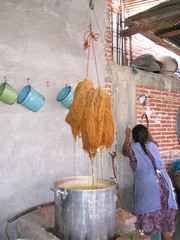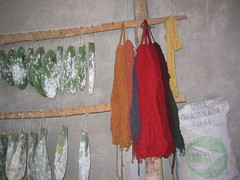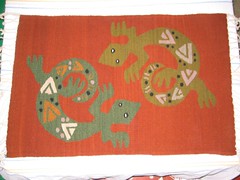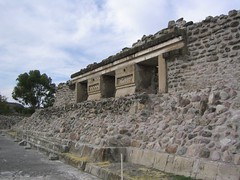A new couple has moved into Jill's old room. They're retirees from Michigan, but they "winter in Puerta Vallarta, south of the río, in the 'romantic' district." Oh boy.
The wife's name is Therese [θə'ɹis], and she was dressed fairly nicely, with a number of pieces of jewelry. She has had enough, she says, of roads with cliffs-as-shoulders, and she wanted to know, honestly, just how bad the road to Monte Albán is. Ann and I tried to assure her that the trip up to Monte Albán is fine.
I didn't mention that, true, it's not the same as an American city street, but it's up a mountain for crying out loud. It really is no worse than, say, the road up to the top of Mount Diablo (and much shorter, besides). The "road" up to the campground at the Russian River campground or "Highway" 4 to Markleeville are far more scary.
Therese and her husband, Jerry, like to just walk around Puerta Vallarta for four months out of the year. By the end of their stay, says Jerry, his Spanish has "warmed up." But he's always wanted to take a class beforehand, as a prep course for their "wintering." So "this is your Christmas present, dear," says Therese.
After Ann and I said goodnight to them, we agreed in a powwow that, as Ann said, "they aren't very nice people." We both worried that they would treat Sofí meanly. And we both hoped that our first impressions were wrong.
But in this case, I'm pessimistic.
Anyhow.
I'm glad I didn't count on Jamie getting back to me about going to Teotitlán. She never emailed me back, and she doesn't go to school anymore. I had way more fun with Ann than I would have had with Jamie et al anyway. Ann's back was, in fact, feeling fine today, so we headed for Abastos and the colectivos there around 10:30. (A colectivo, for those not in the know, is a taxi-sized car that six or seven people cram into, so they can divide up the cost of the trip to the same location. I haven't taken one yet, although the idea of sharing the front bucket seat with two strangers is not as appealing as you might think.)
We were keeping our eyes open for a taxi to take up to Abastos. Ann was concerned about her back acting up early. Almost to the zócalo, we found a taxi. The taxi driver said he'd take up to Abastos, but when we mentioned that we would be looking for the colectivos to Teotitlán, he offered to take us there himself at the rate of US$10 an hour. Faster, more convenient, and more comfortable than a colectivo, at a non-astronomical rate: we agreed.
The driver, Antony ("Tony") turned out to be a surprisingly nice guy. He pointed out notable sights as we passed them on the way to Teotitlán. I told Ann that I hadn't been out in this direction at all yet, so she got out her map and started describing the various places along the highway. Just as we passed el Tule the driver pointed it out. We decided to turn around and go see it, since I never had.
El Tule is this massive tree in front of a village church. The plaque in front of the tree says its common anme (in Spanish, mind you) is ahuehuete or sabino. Its scientific name is T. Mucronatum, family Taxodiaceae, genus Taxodium. It is more than 2,000 years old, 126' tall, 166' around, 42' in diameter, and 636.107 tons. For not being a giant sequoia, it's pretty darn big. ;)
Right when we pulled up to park next to the tree, a procession went past us into the church. It was a local girl's quinceañera! Poofy, glittery pink dress more elaborate than a prom dress, and a band (with tubas!) leading the way and another of her godparents following behind. They set off a bunch of "fireworks" that were really more just gunpowder explosions. Then they all went inside the church, after the bells were done ringing, and began singing. After that we stopped spying on the party, but it really was a big shindig hootenanny. :)
Soon thereafter (because looking at a big tree is only interesting for so long), we got back in the taxi and continued on to Teotitlán del Valle, home of los tapetes. We visited their church first so Ann could show me the intricate wax flowers they make as decorations. A local woman started tagging along after us, telling us where her house was, where we could buy her rugs or her neighbor's wax flowers. Ann eventually claimed that we had some "friends" to visit first. The woman gave us directions, both verbal and written, and finally left us alone.
We did actually go to a specific weaver's house, whose address Ann had written down in her notes from a previous trip. The woman there was very nice and not too pressuring. Unfortunately, I didn't buy anything from her because she was charging more than I was willing to spend. She didn't have immediate competition in her neighborhood to force her to haggle.
She did give us a very cool tour of her workshop upstairs, however. She showed us the nopal leaves where they were cultivating cochineal insects for red, orange, and purple dyes (depending on whether they use the popped cochineal straight, with lemon juice, or a [basic?] water solution). She had many huge skeins of plain shema-colored ;) wool yarn, dyed yarn hanging in various stages of drying, and a vat of dye (today, yellow). Blue dye she gets from a chalk-like paste made from fermented indigo leaves. Nothing local gives a green color by itself, so they have to dye the yarn yellow first, and then blue. It's the same technique they use to get any gradient of colors they want.
She also had three big looms, each set to a different fineness of weave. The coarsest was set to 6 por pulgada, or 3 columns of stitches per centimeter. Next finest was 10 por pulgada, and it went up from there. The finer, tighter weaves also produce thinner, more delicate "rugs" — really more wall hangings at this point. The finest loom she had only produced a centimeter's worth of woven rug per day's worth of work, and something 2' by 4' would take three months to finish! I took pictures of her nicest ones.
We went back to the stalls in the middle of to look for cheaper rugs. I didn't like many of the designs — too busy for my tastes. I eventually bought one with two lizards on it. The couple at the stall initially wanted US$70 for it, but I told tem I was more looking to spend between $30 and $40. I explained that I understood how much work went into the rugs, and I thought they were very pretty, but I just couldn't do more than $40.
I was going to go to the next stall to keep looking, but he asked me to wait. He lowered the price to $60, then $50, but I kept insisting that I didn't have the money for more than $40. (In actuality, I brought a lot more than that with me, but that was all a rug — no matter how pretty or intricate — was worth to me.) He dropped to $45, and I was tempted, but I had told myself I wouldn't pay more than $40 so again I insisted I couldn't.
The wife of the couple kept suggesting I just borrow the extra money from Ann. So helpful. The husband, who did most of the haggling, said that he'd really like to be able to do business with me and sell me the rug ("the last of that design," they said, although I'm not sure why that mattered). Finally, he offered it for $40, I thanked him very very much (might as well make him think I think he's doing me a favor rather than not ripping me off for quite so much, eh?), and accepted that price. I gave him the $40, he gave me the rug, and Ann congratulated me and took my picture with the rug. Like a safari kill or something. :) I feel somewhat bad for the actual weaver, whose per-hour pay can't be much at all, but the rug remains worth to me no more than around $40. I suppose their other option is to hold out for some buyer that does think it's worth more to them.
After I finally had my rug, we got back in the taxi and continued on to Mitla, a town and also an archaeological site. There are really cool Mixtec geometric designs all over the upper halves of the ruins' walls, which would make a great basis for a quilt. There were two tombs under the ruins that I went down into. Really neat, although the one without ventilation to the outside was muggy.
I bought some earrings and matching necklace and bracelet, and a painted ocarina. We got back into the cab and made it back to Oaxaca by 3:15. Tony dropped us off at the seafood restaurant Marco Polo, across from the park Paseo Juarez "El Llano," that Ann had recommended to me earlier. The total cost of the taxi was US$55, split in half for each of us. Marco Polo was quite good; I had red snapper al veracruzana and half a pitche of lemonade.
And, in random internet linkage, have some wine.





2 comments:
" I explained that I understood how much work went into the rugs,"
As well you should know how much work goes into anything hand-crafted, as you have observed for years su madre doing the same sort of thing. :-) (Even to cussing whilst quilting a certain Asian koi quilt. :-) )
"There are really cool Mixtec geometric designs all over the upper halves of the ruins' walls, which would make a great basis for a quilt."
Oh? And did you TAKE PICTURES of the aforementioned basis for a potential quilt?
I'm thinking these weavings take even more effort than the considerable amount you put into, say, koi. ;) Even the fish didn't take you 3 months of straight work, did it?
And yes, yes, I took pictures. While saying to Ann, "Oo, I should show these to my mom. She makes quilts." So nyah.
Post a Comment